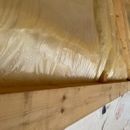Icynene Open Cell Condensation Problem
Hi all,
Looking for some advice regarding spray foam used during the construction of our new home. There is condensation under the plastic used to install the icynene foam in two sections that did not have plywood sheeting (to keep it contained during installation). Foam seems pretty thick (at least 5”) so I’m confused why there would be condensation. We have the temp inside set to 60 degrees and foam still exposed on the inside (no drywall up yet).
Outside temps have been teens to 40s over the last week.
Foam installed about 1-1/2 months ago.
Should I remove that plastic? Would that help? Should I add something else up there?
Any help is appreciated.
GBA Detail Library
A collection of one thousand construction details organized by climate and house part












Replies
Open cell foam is airtight but vapor-permeable. Water vapor always moves from warm and wet to cool and dry, so when it's cold outside, the relatively warm indoor air will do everything it can to get outside. In places where it gets cold outside, it's important to allow the wall to dry toward the exterior, which means no polyethylene sheeting on the exterior. In places where it is sometimes warmer and more humid outside than inside, it's important to not have poly sheeting on the interior. Since most places have both conditions at some point during the year, poly sheeting should never be used in those places.
(There is a workaround that includes exterior closed cell foam but that does not seem relevant to your situation.)
You should remove the plastic so the wall can dry to the exterior. And once you add something like painted drywall at the interior, it will limit how much moisture reaches the foam.
Ok. That’s great news. I’m in the northeast so definitely fall in the hot/cold climate camp. I’ll remove the plastic first thing tomorrow. Thanks for taking the time to explain it all.
As a follow up question, at the top of each wall, the foam contractor took faced r19 fiberglass insulation and cut them to fit in the area where the top of the wall meets the start of the roof (take act as a backer for the foam during installation). He then sprayed the walls and all of the underside of the roof deck. Should I be worried about the faced paper causing the same condensation issues at some point? Or is that less of an issue since it’s not completely impermeable like the plastic sheeting? Thanks again
Creating dams by stuffing fiberglass into cavities is standard practice, though not really best practice, it shouldn't hurt anything. The kraft paper facing becomes more permeable when it's damp so it should be ok.
Ok that’s good. Thanks again for the knowledge. I really appreciate it
I'll add to Michael's excellent explanation that it may be wise to avoid heating before you have the drywall up, so as to minimize the vapor drive into the wall. But removing the plastic is the main thing.
I wish we could. The kitchen cabinets came sooner than expected and had to be stored in the basement, so we turned on the heat for those. We’re on the schedule for the dry-wall guys, so hopefully this week for that.
Would it be necessary to put plywood up there once I remove the plastic to keep out bugs and rodents? Or not worth the effort for little to no gain?